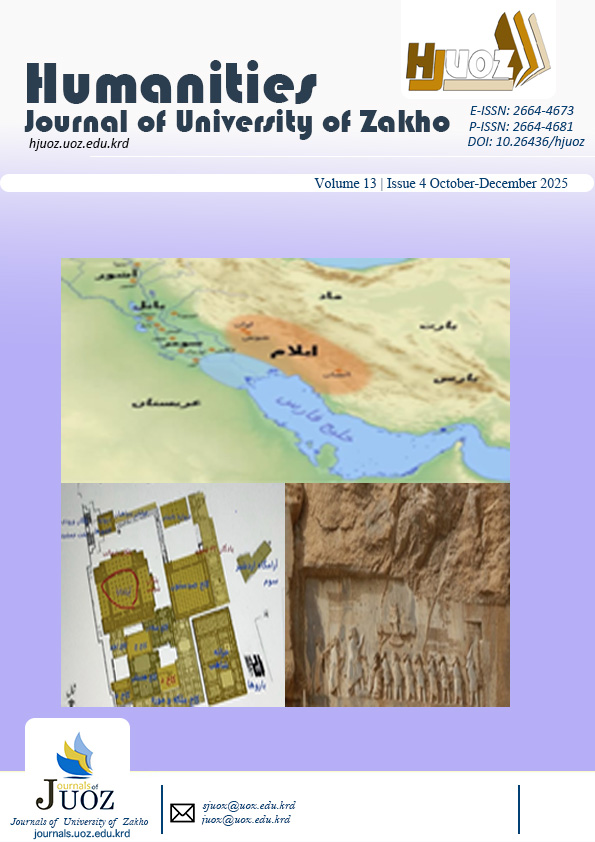ما وراء تعزيز السلطة: منطق ومرونة التطهيرات السياسية في عهد ستالين في الاتحاد السوفيتي، وفي عهد صدام حسين في العراق، وفي عهد بشار الأسد في سوريا
DOI:
https://doi.org/10.26436/hjuoz.2025.13.4.1658الكلمات المفتاحية:
Political Purges,، Authoritarianism، Stalinism، Ba’athist Ideology، Sectarian Violence,، Institutionalized Fear، Kurd، USSR، Syria، Iraqالملخص
تدرس هذه الدراسة عمليات التطهير كآليات نظامية للحكم في الاتحاد السوفيتي في عهد ستالين، والعراق في عهد صدام حسين، وسوريا في عهد الأسد. وبينما تُعتبر عادةً أدوات لترسيخ السلطة، تُجادل هذه الورقة بأن عمليات التطهير تتجاوز الأهداف التكتيكية، وتعمل كممارسات مؤسسية أساسية في مرونة الأنظمة الاستبدادية. وقد عززت هذه الآليات ولاء النخبة، وأعادت هيكلة هرميات السلطة، وقمعت المعارضة، فكانت بمثابة استراتيجيات تكيفية للحفاظ على استقرار النظام. ويحدد التحليل أنماطًا متكررة، بما في ذلك هيكل ثنائي المرحلة يُعالج التهديدات الخارجية قبل استهداف المنافسين الداخليين، إلى جانب الأبعاد الأيديولوجية والبنيوية والشخصية. ورغم الاختلافات الأيديولوجية - الثورة الماركسية اللينينية في الاتحاد السوفيتي في عهد ستالين، والقومية العربية البعثية في العراق، والاستبداد الطائفي في سوريا - تُؤكد النتائج على قابلية عمليات التطهير للتكيف على نطاق واسع في معالجة نقاط الضعف الكامنة في الأنظمة الاستبدادية. من خلال استخدام مفهوم "توازن الخوف" الذي اقترحه وينتروب ونظرية تيلي حول العنف المؤسسي، يعمل هذا الإطار المقارن على إثراء الخطاب حول المرونة الاستبدادية، وإلقاء الضوء على الدور الاستراتيجي للعنف في الحفاظ على سيطرة الدولة.
التنزيلات
المراجع
Aburish, S. K. (2000). Saddam Hussein: The Politics of Revenge. Bloomsbury Publishing.
Amnesty International. Syria: Torture, Despair and Dehumanisation in Tadmur Military Prison. London: Amnesty International, 2001. https://www.refworld.org/reference/countryrep/amnesty/2001/en/40320A
Applebaum, A. (2017). Red Famine: Stalin's War on Ukraine. Doubleday.
Bueno de Mesquita, B., Smith, A., Siverson, R. M., & Morrow, J. D. (2003). The logic of political survival. Cambridge, MA: MIT Press.
Chandler, D. P. (1999). Voices from S-21: Terror and history in Pol Pot's secret prison. University of California Press.
Conquest, R. (1986). The Harvest of Sorrow: Soviet Collectivization and the Terror-Famine. Oxford University Press.
Conquest, R. (2008). The Great Terror: A Reassessment. Oxford University Press
Coughlin, C. (2005). Saddam: His rise and fall. HarperCollins.
Dagher, S. (2019). Assad or We Burn the Country: How One Family's Lust for Power Destroyed Syria. Little, Brown
Daher, J. (2020). Hezbollah: Mobilization and power. London: Pluto Press.
Daher, J. (2019). Syria After the Uprisings: The Political Economy of State Resilience. Pluto Press.
Fitzpatrick, S. (1999). Everyday Stalinism: Ordinary Life in Extraordinary Times: Soviet Russia in the 1930s. Oxford University Press.
France 24 (2024, December 8). Why the Assad regime collapsed in Syria – and why so fast. France 24. Retrieved from https://www.france24.com/en/middle-east/20241208-why-the-assad-regime-collapsed-in-syria-and-why-so-fast
Gelvin, J. L. (2011). The modern Middle East: A history (3rd ed.). Oxford University Press.
Getty, J. A. (1987). Origins of the Great Purges: The Soviet Communist Party Reconsidered, 1933–1938. Cambridge University Press
Getty, J. A., & Naumov, O. V. (1999). The Road to Terror: Stalin and the Self-Destruction of the Bolsheviks, 1932–1939. Yale University Press.
Goldring, E., & Matthews, A. S. (2023). To purge or not to purge? An individual-level quantitative analysis of elite purges in dictatorships. British Journal of Political Science, 53(1), 44–63. https://doi.org/10.1017/S0007123421000569
Hiltermann, J. R. (2007). A poisonous affair: America, Iraq, and the gassing of Halabja. Cambridge University Press.
Human Rights Watch. (1993). Genocide in Iraq: The Anfal Campaign Against the Kurds. Human Rights Watch. Retrieved from https://www.hrw.org/reports/1993/iraqanfal/ANFALINT.htm
Jansen, M., & Petrov, N. (2002). Stalin's Loyal Executioner: People's Commissar Nikolai Yezhov, 1895–1940. Hoover Institution Press.
Karsh, E., & Rautsi, I. (1991). Saddam Hussein: A Political Biography. Grove Press.
Khlevniuk, O. (2015). Stalin: New Biography of a Dictator. Yale University Press.
Kirmanj S and Rafaat A (2021) The Kurdish genocide in Iraq: the security-Anfal and the identity-Anfal. National Identities 23(2): 163–183.
Kirmanj, S. (2013). Identity and Nation in Iraq: Survival in a hostile environment. Lynne Rienner Publishers.
Lesch, D. W. (2012). Syria: The fall of the House of Assad. New Haven: Yale University Press.
Levitsky, S., & Ziblatt, D. (2018). How democracies die. New York, NY: Crown Publishing Group.
MacFarquhar, R., & Schoenhals, M. (2008). Mao's last revolution. Cambridge, MA: Belknap Press of Harvard University Press.
Makiya, K. (1998). Republic of Fear: The Politics of Modern Iraq. University of California Press.
Martin, T. (2001). The Affirmative Action Empire: Nations and Nationalism in the Soviet Union, 1923–1939. Cornell University Press.
Montagnes, B. P., & Wolton, S. (2019). "Mass Purges: Top-Down Accountability in Autocracy." American Political Science Review, 113(4), 1045–1059 https://doi.org/10.1017/S0003055419000456
Penguin History. “When Saddam Hussein Held a Public Purge.” YouTube video, September 7, 2024. Accessed October 9, 2025. https://www.youtube.com/watch?v=MohJLPgutKQ
Phillips, C. (2015). "Sectarianism and authoritarianism in the Middle East." International Affairs, 91(3), 475–497.
Power, S. (2002). A problem from hell: America and the age of genocide. Basic Books.Remmer, K. L. (1989). Neopatrimonialism: The politics of military rule in Chile, 1973–1987. Comparative Politics, 21(2), 149–170. https://doi.org/10.2307/422069
Reuters (2024, December 12). Demoralised and abandoned by allies: Why Assad's army failed to fight in Syria. Reuters. Retrieved from https://www.reuters.com/world/middle-east/demoralised-abandoned-by-allies-why-assads-army-failed-fight-syria-2024-12-12/
Reuters (2024, December 13). Assad's final hours in Syria: Deception, despair and flight. Reuters. Retrieved from https://www.reuters.com/world/middle-east/assads-final-hours-syria-deception-despair-flight-2024-12-13/
Sassoon, J. (2012). Saddam Hussein’s Ba’ath Party: Inside an Authoritarian Regime. Cambridge University Press.
Seale, P. (1989). Asad: The Struggle for the Middle East. University of California Press.
The New Yorker (2024). How Assad's regime crumbled. The New Yorker. Retrieved from https://www.newyorker.com/news/q-and-a/how-bashar-al-assads-regime-crumbled
Tilly, C. (2003). The Politics of Collective Violence. Cambridge University Press.
United States Congress. Congressional Record, vol. 144, no. 15 (Senate), February 25, 1998. “Kamel was killed on his return to Iraq in 1996.” Congressional Record — Senate, S953–S954. https://www.govinfo.gov/content/pkg/CREC-1998-02-25/pdf/CREC-1998-02-25-senate.pdf
Van Dam, N. (2011). The Struggle for Power in Syria: Politics and Society under Asad and the Ba'th Party. I.B. Tauris.
Wintrobe, R. (1998). The Political Economy of Dictatorship. Cambridge University Press.
التنزيلات
منشور
كيفية الاقتباس
إصدار
القسم
الرخصة
الحقوق الفكرية (c) 2025 Soran Tarkhani

هذا العمل مرخص بموجب Creative Commons Attribution-NonCommercial-ShareAlike 4.0 International License.
يوافق المؤلفين الذين ينشرون في هذه المجلة على المصطلحات التالية
[CC BY-NC-SA 4.0] يحتفظ المؤلفون بحقوق الطبع والنشر ومنح حق المجلة في النشر الأول مع العمل المرخص له بموجب ترخيص مشاع المبدع للإسناد
الذي يسمح للآخرين بمشاركة العمل مع الإقرار بحقوق التأليف والنشر الأولي في هذا مجلة
مكن للمؤلفين الدخول في ترتيبات إضافية منفصلة للتوزيع غير الحصري للنسخة المنشورة من المجلة، مع الإقرار بإصدارها الأولي في هذه المجلة
يسمح ويشجع المؤلفين على نشر عملهم عبر الإنترنت

















